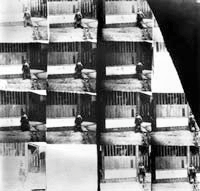| Man Walking Around a Corner | |
|---|---|
 The entire film animated | |
| Directed by | Louis Le Prince |
| Produced by | Louis Le Prince |
| Starring | An unknown man |
| Cinematography | Louis Le Prince |
Release date |
|
Running time | 2 seconds |
| Country | United Kingdom |
| Language | Silent |

Man Walking Around a Corner is an early film/precursor of film, shot by Louis Le Prince in August 1887. [1] It was taken on the corner of Rue Bochart-de-Saron and Avenue Trudaine in the 9th arrondissement of Paris. Pictures from the film were sent in a letter dated 18 August 1887 to his wife. According to David Wilkinson's 2015 documentary The First Film indeed, the work is not a film, but a series of photographs, 16 in total, [2] each taken from one of the 16 lenses from Le Prince's camera. [3] Le Prince went on to develop the one-lens camera, [4] and on 14 October 1888 he finally made the world's first moving image. [5] The total result of the work lasts less than two seconds. [6]